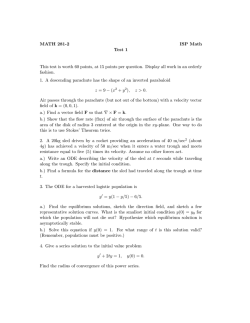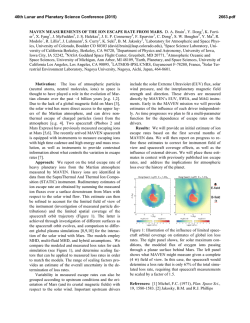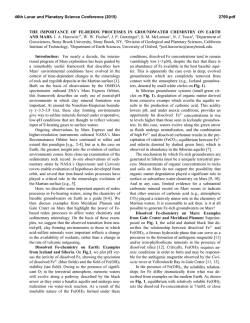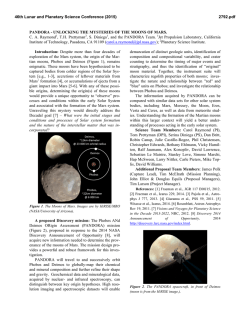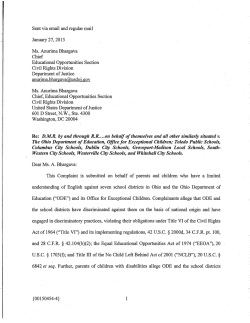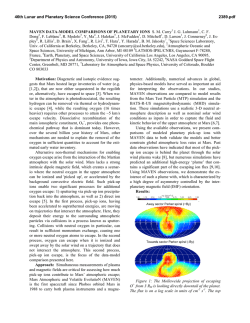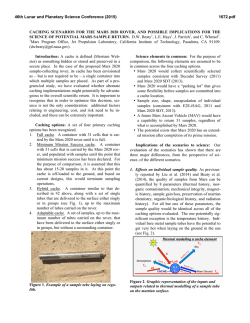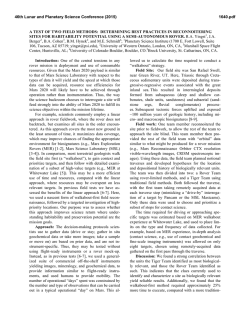
ACCESS PLANETARY DATA THROUGH THE ORBITAL DATA
46th Lunar and Planetary Science Conference (2015) 1560.pdf ACCESS PLANETARY DATA THROUGH THE ORBITAL DATA EXPLORER FROM THE PDS GEOSCIENCES NODE. J. Wang, D. Scholes, K. J. Bennett, F. Zhou, T. C. Stein, J. G. Ward, S. Slavney, E. A. Guinness, and R. E. Arvidson, Washington University in St. Louis, 1 Brookings Drive, Campus Box 1169, St. Louis, Missouri, 63130, [email protected]. Introduction: The Orbital Data Explorer (ODE) is a web-based search tool (http://ode.rsl.wustl.edu) developed at NASA’s Planetary Data System’s (PDS) Geosciences Node (http://pds-geosciences.wustl.edu). ODEs have been generated for Mars, Earth’s Moon, Mercury, and Venus and provide search, display, and download functions for single or multiple PDS compliant archive data products from different planetary missions using product information and/or spatial information. An extension of Mars ODE (http://ode.rsl.wustl.edu/mars/indexproductsearch.aspx) was developed to support the MSL (Mars Science Laboratory) landing site selection process. Currently, 841 terabytes of PDS data are accessible through the ODE. Key features of ODE include coverage-, location-, time-, observational angle-, and product ID-based searching, product browse, and shopping-cart-style download ([1,2,3,4]). ODE supports three granularlevel search capabilities, together with the specialized query tools for subsetting science data at particular regions [5]. ODE also provides a searchable map interface [3]. ODE generates product type coverage KMZ (zipped file of Keyhole Markup Language: KML) files and shapefiles for use with Google Earth and other GIS tools. A special tool for locating Mars Reconnaissance Orbiter (MRO) and Phoenix coordinated observations is under the Tools tab in the Mars ODE. Additionally, ODE provides a Representational State Transfer (REST) interface (http://oderest.rsl.wustl.edu/live, [6]), for external users and tools to access the ODE metadata and products without using ODE web interfaces. ODE Structure: The basic structure of ODE is shown in Figure 1. It consists of a back-end processor, a metadata database, a granular database, a front-end web interface, and a web-based REST interface. Figure 1. ODE Structure ODE metadatabase: The back-end processor application scans PDS nodes and data nodes to extract metadata about data products. The metadata is stored in the ODE metadata database, which is the core of both the ODE web site and ODE REST interface. Through this database, ODE also stores direct links to the PDS product files, thereby allowing direct access to those product files. Granular data: ODE offers a set of tools for extracting granular-level data from selected PDS products [5]. These tools allow users to select granular-level observations from a range of PDS products that cover selected areas and that meet specific criteria. This helps users to generate dynamic derived files efficiently. Currently, ODE supports granular-level search tools for Mars Global Surveyor (MGS) MOLA PEDR (Precision Experiment Data Record), Lunar Reconnaissance Orbiter (LRO) LOLA RDR (Reduced Data Record), and Diviner RDR. These data sets consist of orbit-track oriented products where specific measurements were taken along orbit tracks in time-sequence chunks. To facilitate granular-level searches, the individual granular-level data records are extracted from the products and stored in granular databases. Each granular database has global coverage of the data products. The MOLA searchable database includes approximately 595 million individual PEDR measurements. There are approximately 6.5 billion and 213 billion records for LOLA and Diviner data respectively. Mars, Moon, Mercury, and Venus ODEs each have their own metadata database, web site and associated tools. There are currently a total of 17.2 million PDS products cataloged in ODE metadata databases. The Mars ODE [1,2,3] was developed to aid in the use of data from MRO (Release 31), MGS, Odyssey (Release 50), Viking Orbiter, and the European Space Agency's Mars Express missions. Mars ODE also included selected non-PDS data contributed by the science community to support landing site selection. The Lunar ODE [3] holds data from LRO (Release 20), GRAIL (Gravity Recovery and Interior Laboratory), Clementine, Lunar Prospector, Lunar Orbiter, and Indian Space Research Organization's Chandrayaan-1 missions. The Mercury ODE [2,3] was developed for data from the MESSENGER (Mercury Surface, Space Environment, Geochemistry and Ranging, Release 12) mission. The Venus ODE [4] currently supports data 46th Lunar and Planetary Science Conference (2015) products from the Magellan mission as well as the Venus flyby portion of the MESSENGER mission. A detailed list of current ODE holdings can be found at http://wufs.wustl.edu/ode/odeholdings/index.html. ODE Functions: ODEs provide a web-based tool for searching and exploring the planetary orbital data sets as well as accessing and downloading the PDS archives. The major functions are as follows. Data searching and retrieval. ODEs allow users to search for science data products via form-based or map-based interfaces. Users can make a form-based query by setting parameters of mission, instrument, product type, coverage, location, time, observation angles, and product ID with the form-based Data Product Search interface. Users can also make queries on the Map Search interface with the tool Select Products By Area or by setting parameters in the Map Display Controls panel. ODE supports queries on both single and multiple missions, or searches among single and multiple instruments. Search results are shown in a table or on a map. Data representation. Details of search results are shown in a table with a set of functions to select more product information such as browse, metadata, PDS label, or map context. The browse version of imageoriented products provides an overview of the product to help users make downloading decisions. In addition, users may view the products with the footprints or bounding boxes plotted on a basemap. Map display. The ODE web map includes both footprint coverage and basemap layers. The footprint coverage maps display the location of data products. Each map layer includes all of the product footprints per instrument product type. Each footprint shows an individual product's surface area coverage. The basemap layers provide context background. The footprint maps are overlaid on a number of basemaps. The transparency of each map layer can be adjusted in order to provide for combined presentation of layers. Some footprint maps, such as CRISM TRDR, DDR, DIVINER and LROC are slow to display due to the large number of product footprints rendered on the map layer. These layers are highlighted with an icon indicating their expected performance. The ODE web map interface was built based on the ESRI® ArcGIS Server and ArcGIS JavaScript API. Basic functions include map display, pan, zoom in/out, and navigation. Data Download. Multiple options are provided for acquiring data products from ODE. Users can select and order data products using a web-based “shopping cart” approach, or directly download individual files through the ODE interface. 1560.pdf Footprint coverage maps in KMZ and shapefile format. As mentioned, footprint coverage maps allow users to see what portion of a planetary surface is covered by the footprints of all products of a given product type of a given mission and instrument. ODEs generate product-type coverage KMZ files and shapefiles for further access of the product coverage data with Google Earth/Mars/Moon or other GIS tools. The coverage files include basic product information and links to product details in ODE to assist the user in acquiring product files through this method. Coordinated observations. A coordinated observation is a planned observation involving multiple instruments at a given location and time. A coordinated observation search tool was developed specially for the MRO mission. It allows users to find and view related products from MRO HiRISE, CRISM, CTX, and MCS, as well as the Phoenix Lander data. REST interface. ODE also provides a simple webbased REST interface to allow other groups to develop specialized or domain-specific interfaces to search for PDS products, obtain metadata about those products, and download the products through the urls stored in ODE’s metadata database. Additionally, the ODE REST interface also supports MOLA PEDR, LOLA and DIVINER RDR granular-level queries. The query results are the same as the current ODE web-based granular query. Future Development: New data sets and continued PDS releases will be imported into ODE. An updated Map Search interface is currently under development with the goals of improving performance, usability, and the process of individual product display and download. Contact Information: The Geosciences Node welcomes questions and comments from the user community. Please send email to [email protected]. Comments and questions on ODE and REST access can be sent to [email protected]. References: [1] Bennett, K. et al. (2008), LPS XXXIX, Abstract #1379. [2] Wang, J. et al. (2009), LPS XL, Abstract #1193. [3] Wang, J. et al. (2010), LPS XLI, Abstract #2251. [4] Bennett, K. et al. (2013), 44th LPS, Abstract #1310. [5] Wang, J. et al. (2011), 42nd LPS, Abstract #1896. [6] Bennett, K. et al. (2014), 45th LPS, Abstract #1026.
© Copyright 2025
